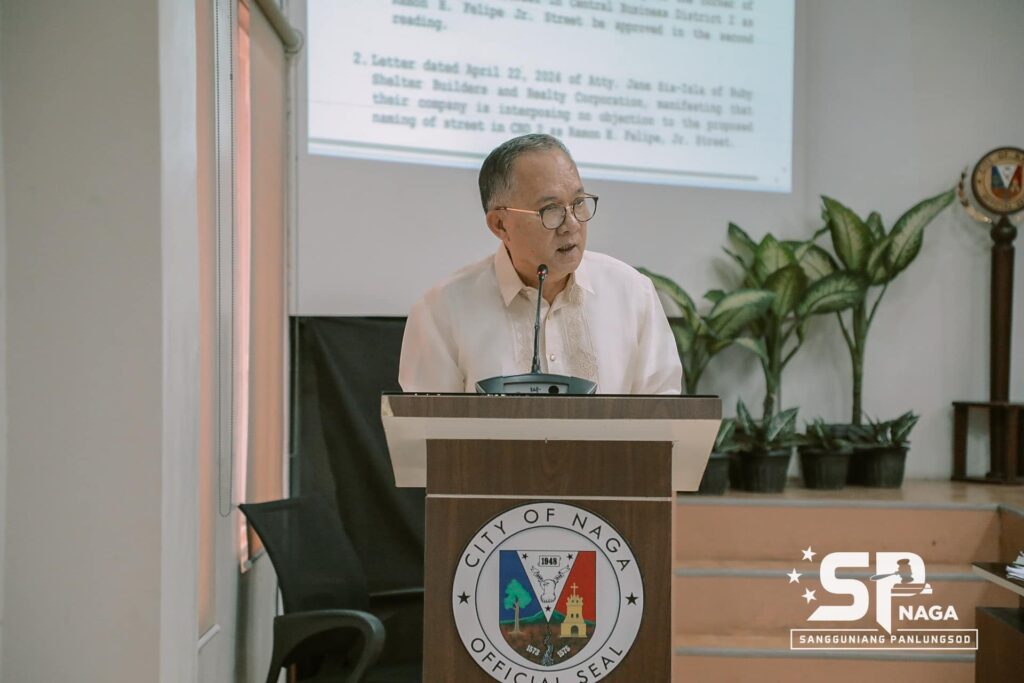
The Sanggunian Resolution declaring as important cultural properties (ICP) the two Spanish-era stone buildings located in Barangay San Francisco in downtown Naga has finally been approved after it was signed by City Mayor Nelson S. Legacion and formally transmitted to the Sangguniang Panlungsod during its regular session last Tuesday, June 25.
Resolution No. 2024-264 is actually a repassed resolution with amendments after satisfying the mayor’s earlier request to bolster the original Resolution No. 2024-054 with more proof and evidentiary documents to declare the ancient structures as important landmarks.
The two stone buildings are situated in a property along Penafrancia Avenue that once belonged to the provincial government of Camarines Sur and sold to then PhilAm Life Insurance Company sometime in early 1990s under then Gov. Luis Villafuerte. For over 30 years now, the property was left idle until it was resold about two years ago to Nagaland Development Corporation (NDC) owned by the family of Atty. William Enrile. The private company has been known to have bought several prime properties in the city’s old business district and elsewhere and turned them into a mall, hotel or leased to other commercial establishments.
On November 16, 2022, the National Historical Commission (NHCP) issued a cease-and-desist order to NDC chairman Atty. William Enrile “suspending all activities involving the demolition of built-heritage (referring to the two remnant Spanish-era stone buildings located in Barangay San Francisco along Penafrancia Avenue)”.
On October 10, 2023 Mayor Legacion wrote Atty. Enrile a letter reminding him of the city government’s commitment to preserve its rich history and culture and suggested the adoption of “adaptive reuse” to conserve the site while utilizing the structures for whatever purpose the Enriles, as private owners, may intend to do.
But on the 20th of the same month, Atty. Enrile wrote Mayor Legacion to request “for non-inclusion of said colonial structures from the Naga City Ordinance No. 2003-003 listing (of) certain cultural and heritage buildings, inasmuch as the property has not been proven to have any cultural or historical significance/importance other than being old buildings.”
When Mayor Legacion requested for a technical team from NHCP to come to Naga City to settle whether or not to lift the presumption as important cultural property of the old Spanish-era buildings, Dr. Emmanuel Franco Calairo, the new NHCP chairman, responded that “only the NHCP Board of Commissioners has the authority to approve or disapprove the lifting of presumption as ICP thru an NHCP board resolution.”
Calairo instead requested the Naga City government “to submit a resolution stating that the said structures … either hold or do not possess any local historical, socio-cultural, and architectural significance as requisite for the lifting of presumption process”.
Thereupon, the Sangguniang Panlungsod Commission on Culture and the Arts chaired by Councilor Joe Perez, called for a series of hearings and consultations inviting all stakeholders in the arts and culture sector and the Nagaland Development Corporation to exhaustively discuss the matter. The ensuing consultations and deliberations lasted for over a year which included research, document retrievals, and constant travels to the national library, museums, and the National Archives, books and journals, surviving witness’s accounts, ocular inspection, and even correspondence from the Spanish Archives in Madrid. The local architects even presented proposed designs for “adaptive reuse” which are similar to or patterned from Manila’s surviving historical landmarks and those from abroad.
The first resolution by the Sangguniang Panlungsod was unanimously passed in early 2004 declaring the contested site as an important cultural property because they hold local historical, socio-cultural, and architectural significance and should therefore be part of Naga’s heritage and history.
But the request of the mayor for more reference materials – not only position papers, letters, or arguments – as factual basis for him to finally act on the matter led Councilor Perez and his SP committee members to go back to work and asked the parties concerned – Nagaland Development Corp on one hand and at least 7 groups/organizations belonging to the arts and culture sector including the local chapter of the United Architects of the Philippines (UAP) on the other to submit their final positions backed up by more factual materials within a period.
In the repassed Resolution No. 2024-264, more annexes were attached bolstering the cultural and historical, as well as architectural significance of the Spanish-era landmarks.
In one of the annexes, the building ruins themselves were presented, especially the inscription with “1826” on the right hand building and the discernable Spanish-era stone material and architecture of the two buildings similar to other 19th century Spanish buildings in the Philippines.
Fr. Francis A. Tordilla, himself a historian and rector of the ancient Seminario Conciliar de Caceres (otherwise known now as the Holy Rosary Minor Seminary), shared with the committee an 11-page “Summary of Manuscripts found in the Archivo Historico Nacional de Madrid” listing manuscripts and photographs of some of the sketches of the two old building’s locations and designs.
In a note, he wrote that “(h)istoricity is not limited to a single event like that most claimed that Alias Angeles and Felix Plazo were imprisoned in these calabozos (jails). A building or a house may be historically valuable if it can be an example of a style of architecture or an industrial process that’s no longer used, or simply for its age…”
He further stressed that “(e)ncouraging historical thinking using buildings offers the opportunity to model historical expertise that grounds historical inquiry in places and media that are accessible and meaningful to students at every level of historical interest, ability, and understanding.”
Formally acknowledging receipt of the copy of the approved Resolution during last Tuesday’s session of the Sanggunian, Councilor Perez expressed his gratitude to Mayor Nelson Legacion, SP Presiding Officer Vice Mayor Nene de Asis, his fellow councilors, and the various stakeholders, including the Nueva Caceres Heritage Movement, the UAP Naga chapter, Sumaro, and the Naga City Arts and Culture Coalition, for firmly playing their roles that eventually resulted to the declaration of the Spanish-era structures in Naga City as important cultural properties.
Perez said the Resolution’s approval was a triumph for Naga, its rich history and culture.
Written by Jason Neola (CEPPIO)
